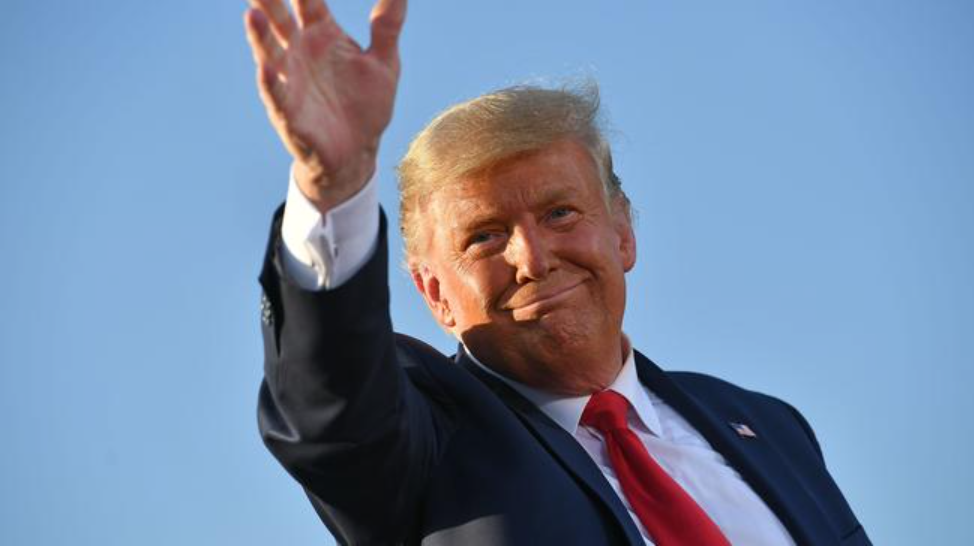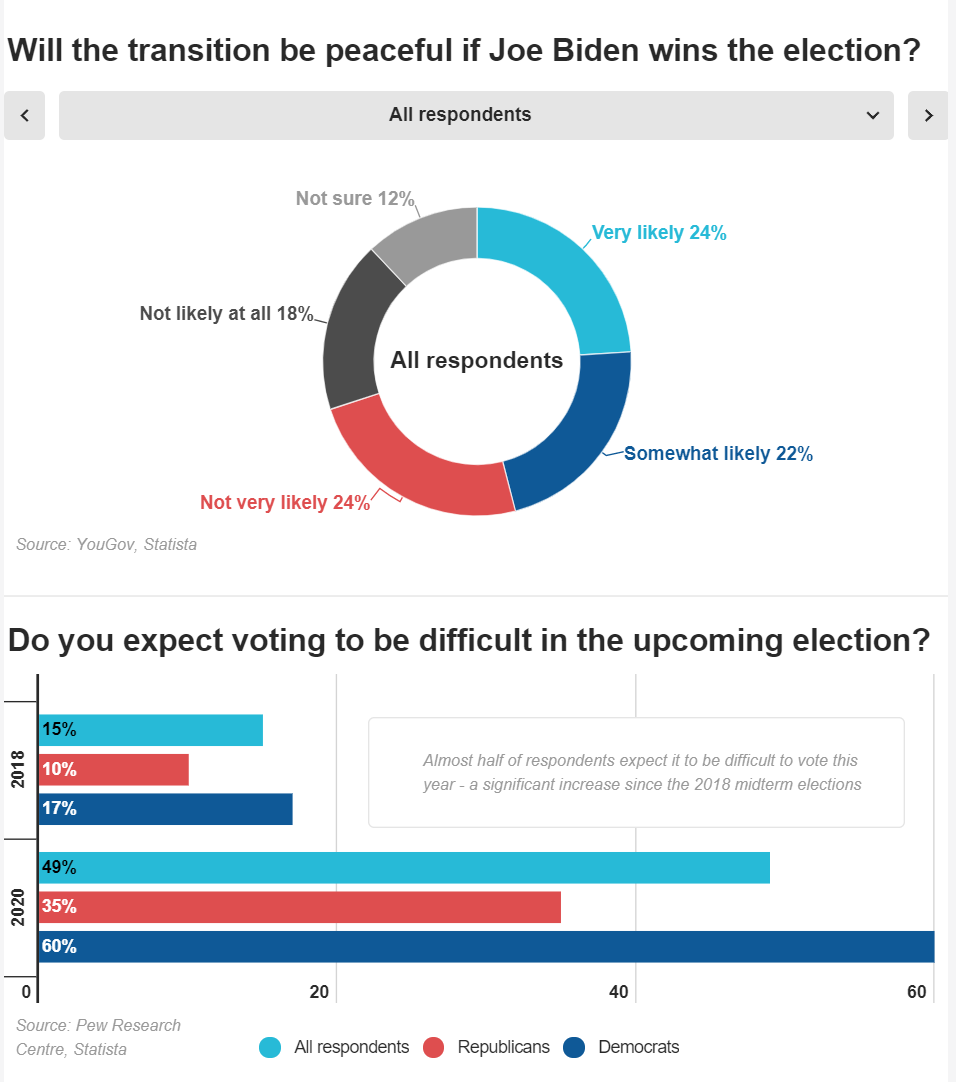
This article is more than
6 year old
Don’t believe the opinion polls – Donald Trump is actually ahead of Joe Biden.
That’s according to Robert Cahaly from The Trafalgar Group, who was one of the few pollsters to correctly call the 2016 election.
Mr Cahaly, who describes himself as a “polling industry disrupter”, is predicting another Trump victory next month.
“If it all happened right now my best guess would be an electoral college victory in the high to 270s, low 280s,” he told National Review’s podcast The Editors.
“Over our five years, on the races we’ve submitted publicly, our record is 92.6 per cent of the time we’ve called the winner right.”
Real Clear Politics polling averages currently put the Democratic nominee ahead of the Republican nationwide by 8.6 per cent – 51.1 to 42.5 – and also in every single one of the key battleground states of Florida, Pennsylvania, Michigan, Wisconsin, North Carolina and Arizona.
One positive sign for Mr Trump, as noted by Mollie Hemingway from The Federalist, is that he is actually polling better against Mr Biden in those battleground states than he was against Hillary Clinton in 2016, according to Real Clear Politics’ own numbers.
Separately, another poll credited with being one of the only accurate national surveys in 2016, the Investor’s Business Daily tracking poll, on Tuesday revealed the US President suddenly closing the gap with his rival.
And even Mr Biden’s campaign admitted: “We are not ahead by double digits.”
Campaign manager Jen O’Malley told an online grassroots summit on Friday: “Those are inflated national public polling numbers.”
Polling analysis website FiveThirtyEight, however, still gives Mr Biden an 87 per cent chance of winning the election.
“President Trump is running out of time,” FiveThirtyEight wrote.
“Joe Biden leads by double digits in national polls, and state-level polling is only slightly closer. In fact, Biden’s lead is so large that traditionally red states like Georgia, Iowa, Ohio and Texas might now go blue.”
The website warned that with two weeks to go, “we’re way past the point where a normal polling error could let Trump close the gap”.
“Still, Trump has a meaningful chance per our forecast – a little worse than the chances of rolling a one on a six-sided die,” it said.
Preview https://infogram.com/untitled-infographic-1ho16v7m807v6nq?live

Mr Cahaly, however, disagrees.
The Georgia-based political consultant doesn’t put much stock in the quality of traditional polls, which he argues are rife with methodological errors. In 2008, he realised the polling he was getting for races he was working on wasn’t very accurate, so he started conducting his own.
Trafalgar Group’s big success came in the 2016 election.
“We ended up having an incredible year,” he told National Review.
“I mean, we got Pennsylvania right. We got Michigan right. We had the best poll in five of the battleground states in 2016. And I actually predicted 306 to 232 on the electoral college. And we went from doing a little bit of polling on the side to that (being) our primary business in about 24 hours. And since then, that’s what we’ve been doing.”
Mr Cahaly says he gets more accurate results “because we poll people in a different way”.
“They call me a polling industry disrupter because I reject a lot of the sacred cows,” he said.
For one thing, he doesn’t believe in long questionnaires – he typically asks seven to nine questions and “the whole thing takes less than three minutes”, whereas most polls are “north of 25” questions and in some extreme cases up to 180.
“You’re calling up mum or dad on a school night and they’re trying to get the kids dinner and get them to bed, and that phone rings at 7 o’clock and they’re supposed to stop what they’re doing and take a 25, 30-question poll?” he said.
“No way. My question is, who’s taking these polls? Do you know anybody who’s got 25 minutes to kill on a weeknight? I don’t. So you end up disproportionately representing the people who like to talk about politics, which is going to skew towards the very, very conservative, the very, very liberal, and the very, very bored.”
That leaves out people in the middle – “The kind of people that win elections.”
The other big difference in his method is accounting for the “shy” voter phenomenon.
“We do not like to do all live calls because (you get) this thing called ‘social desirability bias,’” he said.
“People want to say what they think will make them look good and they don’t want to be judged by somebody on the phone they don’t know, so it tends to err on the side of giving the most politically correct answer.”
RELATED: Big change after debate trainwreck
RELATED: What Trump will do if he loses election

In the UK it’s known as the “shy Tory”, while in the US it has also been known as the “Bradley effect” after Tom Bradley, the African-American mayor of Los Angeles who underperformed his polling when he ran for governor in the 1980s.
Mr Cahaly said voters in 2016 “didn’t want to admit they were voting for Trump”.
Similarly in the 2018 Florida governor’s race between Democrat Andrew Gillum and Republican Ron DeSantis, “people were saying they were for Gillum who had no intention of voting for Gillum”.
“The way you minimise the social desirability bias is you make the person feel the most anonymous,” Mr Cahaly said. “I’ve got to get past what you want to say in public and get to what you really feel, because what’s in your heart is what’s going to be on that ballot.”
Trafalgar Group uses a variety of different methods, including live calls, digital questionnaires, texts – which he says generate huge response rates from often difficult-to-reach younger voters – emails and a “proprietary digital platform” that Mr Cahaly won’t explain.
“And there’s different ways to do it when you do a live call, but really push the anonymous part – this is your anonymous say-so,” he said.
Mr Cahaly also points out another big problem with traditional polling – conservatives in general are less likely to participate.
“We see a five-to-one refusal rate among conservatives (versus progressives). You’ve got to work very hard to get a fair representation of conservatives when you do any kind of a survey,” he said.
To account for this, pollsters will give greater “weight” to a smaller Republican sample to make up for a shortfall in responses, but Mr Cahaly says one problem is that Republicans “who don’t like Trump can’t wait to answer a poll”.
“So immediately, within the 22 per cent, they’ve probably overrepresented it, the anti-Trump Republicans, the Never Trumper types,” he said. “Well, when you weight that up from 22 to 35, now you have skewed an already bad representation sample. So that’s kind of inherently how they can be so off.”
He adds that all of the sampling issues are magnified in national polls.
“It’s easily skewable at that point,” he said. “You start making assumptions.”
Speaking on Fox News, Republican political consultant Karl Rove agreed there “is a shy Trump voter”.
“We saw it in (2016),” he said.
“Take a look at all of those polls that were conducted (in the last week), they showed Hillary Clinton was going to win the nationwide popular vote by almost 3.5 per cent and she won it by just over 2 per cent. So they were off by a third on her margin, and they could conceivably be off this time around.”
Mr Rove added that pollsters “have been thinking about” the issue but “we won’t know how good anybody’s gotten at evaluating this until after the election”.
Based on his current polling, Mr Cahaly predicts Mr Trump will win the battleground states of North Carolina, Florida, Georgia, Arizona and Michigan, but lose Pennsylvania.
He claims, however, that Pennsylvania is “the number one state that Trump could win and have stolen due to voter fraud”.
His comments were made before the Supreme Court ruled on Monday that Pennsylvania could continue to count mail-in ballots up to three days after election day – even ones without postmarks – drawing outrage from Republicans.
“Democrats are trying to steal the election, after the election,” Ohio congressman Jim Jordan tweeted after the ruling. “Chief Justice (John) Roberts is letting them do it.”
National Review columnist David Harsanyi noted, “If Pennsylvania is really close, and a bunch of ballots come in three days later – without postmarks – to decide the election, it’s going to be really ugly.”